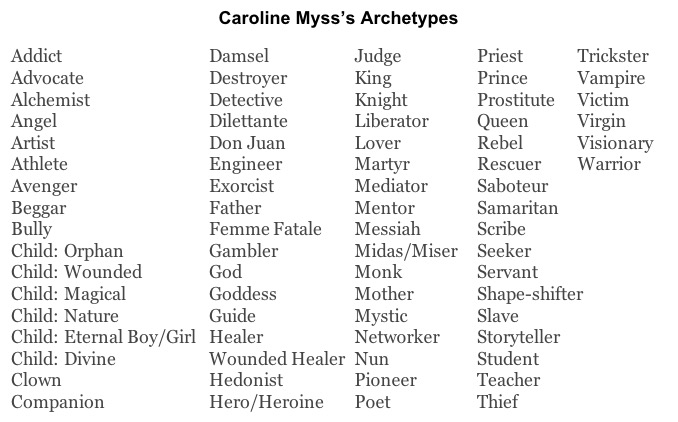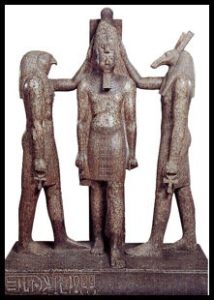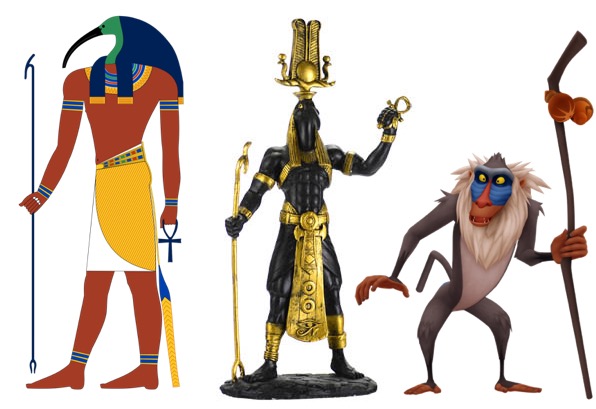Who & What are the Kemetic Archetypes?
There are numerous beings ruling, influencing, guiding and inspiring most of our behavior, which Swiss psychiatrist Carl Jung called archetypes and the Greek philosopher Plato called Forms.
Correction. Plato was not the first to write about archetypes or forms but he was the first man recognized by Westerners to document them. No one really knows who was the first to write about forms or archetypes because this concept is so old and legendary that it crosses over into myth, which is the reason Jung found archetypes in legends, myths, religions, etc. all over the world.
The reason most people have not heard about archetypes and/or how to consciously work with archetypes is because Western archeologists, historians, theologians and other scholars with their limited understanding of metaphysics and the human mind, referred to them as gods and goddesses.
The reason most people have not heard about archetypes and/or how to consciously work with archetypes is because Western archeologists, historians, theologians and other scholars with their limited understanding of metaphysics and the human mind, referred to them as gods and goddesses.
If we stop and analyze all of the ancient cultures we will find that there is a reason the same gods and goddesses appear in legend and myth all over the world. There is a reason similar legends and mythological themes appear all over the world. If archeologists, historians, theologians and other scholars were not so biased and would divorce their political and religious ideologies from academia. They would have realized that all of the so-called pantheons listing various gods, goddesses, spirits, etc. were simply maps and models of the human mind. More will be said about this below.
Yes. You read it correctly. Thousands of years before Jung’s great-grandparents were born, ancient cultures from around the world had mapped out the human mind. In other words, what we have been told by archeologists, historians, theologians and other scholars, that was repeated by our parents, teachers, minsters, etc., as being gods and goddesses are simply archetypes and forms.
So, if we revisit all of those childhood questions that we had when we first heard about gods and goddesses, such as why are there so many of them. Like there are four gods in the Hawaiian and Polynesian religions, 16 gods in Taoism, 40 in Yoruba-based religions, 200 in the Aztec religion, 33 million gods in Hinduism, and Jung identified 12 (archetypes), which many Jungian adherents state is around 300, and so on. It is because this is how mysterious, complex and powerful our mind is. In fact, Jung believed that concluded that we each had Self, Anima, Animus, Shadow, Persona, Father, Mother, Child, Wise Old Sage, Trickster, Maiden and Hero archetype.
Meanwhile the Greek believed we had Zeus, Hera, Poseidon, Demeter, Ares, Athena, Apollo, Artemis, Hephaestus, Aphrodite, Hermes, Dionysius, Hades, Hypnos, Nike, Janus, Nemesis, Iris, Hecate, Tyche, as archetypes or gods and goddesses,
In other words, think of each archetype or god and goddess as an unconscious action, behavior, and emotional part of your being, or. As a different behavioral pattern and subtlety that exists within you. This means that since the gods and goddesses reside within our unconscious that there are thousands upon thousands of them. And, every time some event occurs in our life, the way we respond to it is influenced by one or two of these so-called gods or goddesses.
For instance, to set the mood for passion most of us will automatically burn a light colored candle, turn on some relaxing, soothing and sultry music and have a sweet smelling fragrance because we are influenced by the Lover archetype, which the Greeks Eros, the Romans called Cupid, which the Kemetic people referred to as Bes. All of whom were associated with the archetype of beauty and lust, that the Greeks called Aphrodite, the Romans called Venus and the Kemetic people called Nebthet (Nephthys).
Seeing Your Archetypes In Life
In recent years more and more people are discovering what archetypes are by recognizing the archetypal patterns that exist in their life. For instance, in Caroline Myss’ award winning book Sacred Contract, the author indicates that her father wanted her to be either a nurse or a teacher. She mentions how she avoided the classroom and nursing profession for the longest time but found herself drawn to nursing and teaching people. She states that although she is not a teacher or nurse per se, what her father saw was a glimpse of her sacred contract which had a Healer archetype and a Teacher archetype.
Myss was able to discover her archetypes by differentiating herself from her archetypes. By separating herself, the I part of her being, from her archetypes. She was able to identify and compile a list of how her archetypes influenced how she thought, felt and interact with her in her life.

But, ancient cultures also understood that to identify and work with their archetypes they had to separate themselves. The reason you must separate yourself from the archetypes is because failure to do so will result in you seeing them solely as mental constructs, hence multiple personalities.
Another discovery that the ancient cultures made is that by separating themselves from their archetypes or gods and goddesses. They could identify how the archetype was influencing them and in-turn influence the archetype. Failure to understand this is what led Western scholars to believe that these ancient cultures were idol worshippers or polytheist, which I hope you are beginning to see what advanced psychology.
As I previously mentioned, most of us know how to set a loving and passionate mood for our mates by burning soft candles, having a romantic dinner, playing soft music, etc. Every time we do this we are (technically speaking) evoking the archetypes or gods and goddesses of Love, Passion, Beauty, Sex and Lust.
The reason most of us do not recognize this is because unbeknownst to most is that Jung was mentored by his colleague and former friend Sigmund Freud. Freud who through analysis, research and study theorized that the unconscious mind as a wild and chaotic aspect of the mind. Freud painted a picture to most that the unconscious mind was responsible for people being crazy, mentally ill and psychotic thus giving the allusion to many that we are preys to it. Individuals who were not crazy, mentally ill or psychotic could attribute their sanity to affluence and luck.
Jung parted ways from Freud by realizing that everyone (including himself) was crazy, mentally ill and psychotic which he attributed to the unconscious being fragmented. In other words, all of the archetypes or gods and goddesses are complex personalities expressing themselves from within. This means that the difference between an individual with multiple personalities and you, is that you can clearly identify and separate each, whereas an individual with multiple personalities has difficulty doing so.
This is why the ancients created a pantheon The numerous legends and myths once understood from a metaphysical perspective are not stories retold for entertaining purposes, but allegorical formulas to help people organize their unconscious mind.
The Genius in Kemetic Spirituality
It cannot be overstated that the reason we misunderstood most of the ancient spiritual systems is because Western archeologists, historians, theologians and other scholars with their bias, political and religious agendas. Failed to understand that we are multi-conscious beings, and that our mind is just as complex and systematic as our physical body. Once we keep this firmly in mind and observe the spiritual systems of these ancient cultures. We see that the so-called gods and goddesses are all archetypes.
The best example of this can be found in the oldest recorded spiritual system in existence, the Kemetic (Ancient Egyptian) spiritual tradition. For thousands of years the Kemetic spiritual system centered around one story called the Story of Osiris and Isis, Osiris and Set, Horus and Set or the Story of Osar. Archeologists, historians and theologians will tell you that the Kemetic people were obsessed with death but a closer look will reveal these scholars had no clue.

For simplicity purpose, the Story of Osar is said to have occurred prior to Kemet being united into one kingdom. According to the legend, the people of Kemet were uncivilized until Osar who desired peace discovered/learned how to help his people. The story states that Osar traveled all over the country teaching his people laws and the science of agriculture which he learned from Oset (Isis). Shortly upon doing so the pre-dynastic Kemetic people ceased warring with one another and begin to work with one another in harmony, which made everyone peaceful and prosperous. All loved and were extremely grateful for Osar except for his youngest brother Set who plotted and killed Osar, then usurped the throne. For years, Set’s rule went unchallenged until Osar’s wife magically conceived Osar’s heir Hru (Horus). When Hru came of age he challenged Set but was unable to defeat his older and craftier uncle. After losing his eye and coming close to almost losing his life, Hru sought out his father’s friend and vizier the wise Djahuti who repaired his eye (sight). The next time Hru met Set on the battlefield, he defeated his uncle and forced him to surrender. The story continues with Set obstructing all of Hru’s effort until finally being defeated in a court of law.
Now, when we take into consideration all that has been said above we see that the Kemetic people did not worship false gods and goddesses. The numerous gods and goddesses of Kemet were all different aspects of the human mind that their ancient sages, priests and priestess had mapped out hundreds of years before Plato’s Forms. This is why the same archetypal theme of an avenging prince can be seen in Hamlet, The Lion King and quiet as kept in the Christian religion.
It is very easy to interpret this story literally, which is why the Story of Osar is considered to be one of the greatest stories of humanity. But, you will receive a richer and more profound understanding if you move beyond the superficial and interpret the story from a metaphorical perspective. Once you do this you will easily see who is acting in the role of Osar, Set and Hru in your life and throughout society. However, when you delve deeper into the story from a metaphysical perspective. You will begin to see that the envious and evil youngest brother Set is the symbol for the chaotic unconscious mind or the lower self, while Osar symbolizes the tamed aspects of the unconscious mind or the Higher Self. Thus, indicating that Hru represents the middle ground or the one who ultimately has to choose to either follow his/her Osar (Higher Self) or Set (lower self).
In other words, we all have an untamed, wild and chaotic archetype who influences our behavior that the Kemetic people called Set. This archetype, form, god and goddess or more appropriately energy is responsible for most of our negative habits, personality traits, behaviors and actions. It is stubborn (like a donkey or jackass), excessively greedy and selfish (like a pig), noxious and venomous (like poisonous snakes), which you will note are all animals in some sense tied to egotistical behavior hence our subconscious or lower self.
Thankfully, we all have an Osar within us who whispers to us after we have exhausted all of our physical resources. Unfortunately, our Osar usually speaks to us all the time but because we are conditioned or in the habit of following the needs and wants of our Set. We usually ignore our Osar which is the reason this is allegorized in the story as Osar being murdered and usurped by Set. This is why our Osar appears to us as a quiet little voice speaking from within.
Thankfully, most of desire to do better and when this desire is strong enough. It gives birth to our Hru who will champion our cause. But it is not enough to just want to defeat Set, just like it is not enough to want to break a destructive habit, complete an exercise regimen, cease consuming chocolate, be successful on the job, make money, etc. The reason most of us fail to accomplish our will is because you cannot just talk to your lower self or Set and make it do something. You must program your lower self (Ego) or subconscious which requires that you seek the assistance of a wise and sagely individual symbolized as Djahuti (Thoth or the monkey in the Lion King).

Once we understand that thees so-called gods and goddesses are energies that exists within us and throughout the universe. We can begin to see that the genius of Kemetic Spirituality is that all of the archetypes, gods and goddesses or energies are described as being members of the same family or children, grandchildren and great-grandchildren of Ra. This is done to help people to understand that no one is inherently good or evil. We all have both Osar and Set within us. We can either choose to follow our Osar (Higher Self) or Set (lower self), but ultimately the choice is ours.
How to Identify & Work With Your Archetypes the Traditional Afrikan Way
There are numerous ways you can connect and work with your archetype. A few of the easiest ways is by first identifying who your archetypes are by familiarizing yourself with the legends, myths and/or fairytale that resonates with you the most. Second, ask yourself which archetype(s)/character(s) resonates with you the most, and. Third, trust your intuition and listen to the answer that intuitively comes to you.
To begin working with your archetypes know that these spirits/energies will not tell you to do something that is contrary to your beliefs. Once you identify who your archetypes are, you might want to familiarize yourself with your archetypes’ favorite colors, scents, foods, etc. For instance, in the Kemetic shamanic tradition Osar’s favorite color is white (some will say all variations of white), and all things that are white including rocks, stones, flowers, foods (e.g. rice, potatoes, coconuts, etc.). So by offering a glass of water and/or even a white candle to your Osar will get your Osar’s attention.
Another suggestion is to pay attention to your dreams. Eventually, your archetype will make itself known to you. Once, you make that connection, that is when your journey begins.
